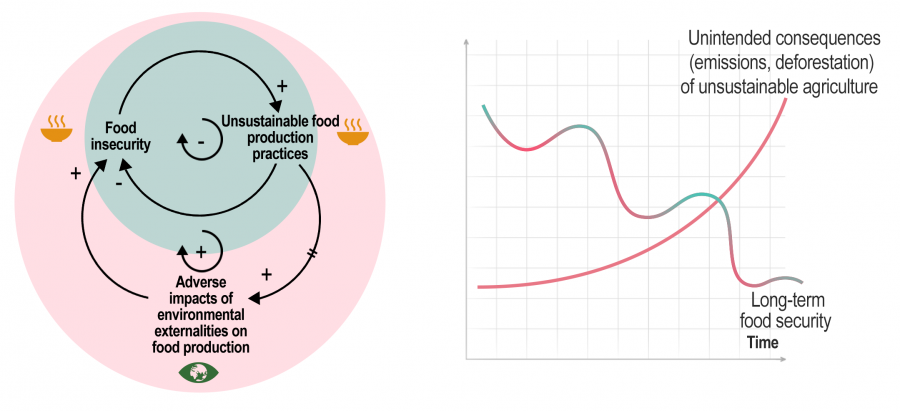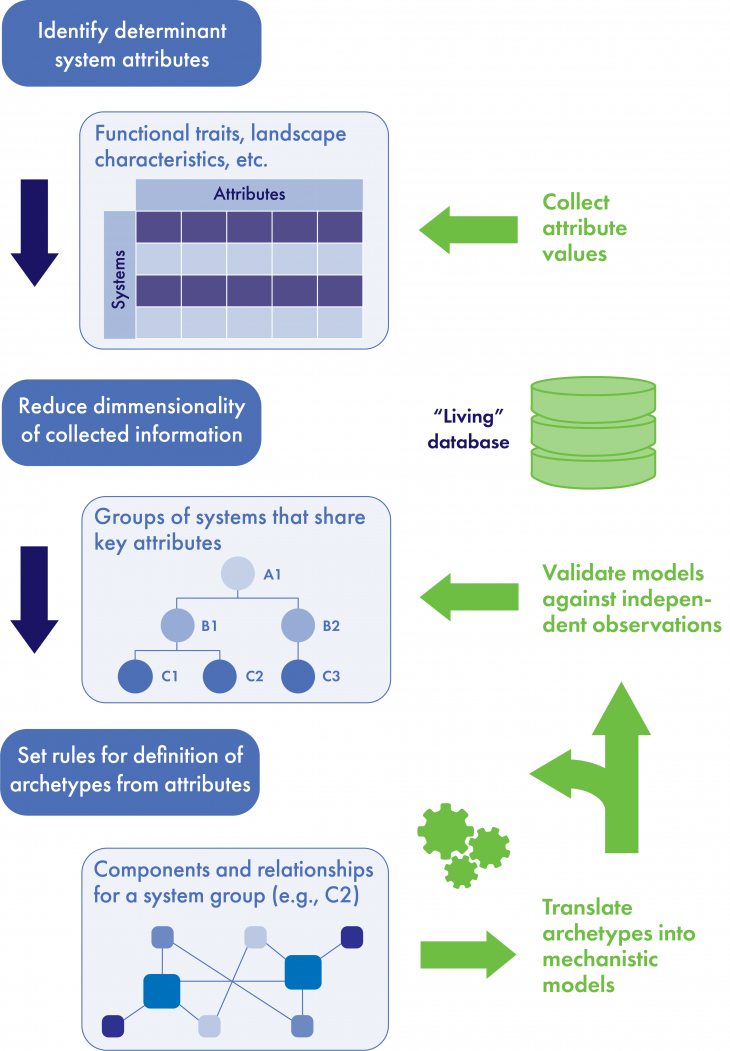A downloadable version of this explainer is available here:
Solving problems of sustainability requires understanding social and environmental systems as being tightly coupled. Each system’s individual components or parts interact in complex ways, and understanding feedbacks, or how change in one part of the system affects other system parts, is critical. Feedbacks can help researchers to determine systems’ outcomes and how they will affect humans and the natural world at different scales—from local to global levels. Researchers also recognize that how people, species, and other system components interact is often context-dependent and understanding that context dependency is key for solving socio-environmental (S-E) problems. However, if we assume that every S-E problem is totally unique, we can easily feel unsure as to where to even begin.
Archetype analysis, which involves looking for and understanding patterns in our data, is one method that can help us move forward from this paralysis. Archetype analysis can reveal not only patterns that commonly plague S-E systems but also strategies for achieving sustainability across heterogeneous contexts (Eisenack et al. 2019). With its particular focus on using feedback loops as the leverage point for solving sustainability problems, the use of archetypes is growing in research and management.
What Are Archetypes?
Archetypes are topologies, groups, or categories that have similar characteristics and patterns. While each individual case that relates to a certain phenomenon may have unique characteristics, it’s often possible to recognize similar attributes among them. In the context of S-E systems, archetypes are basic, recurrent patterns of feedback loops in the system that produce similar dynamics (Senge 2006). Researchers often use archetypes to characterize structures or processes that are common across many specific S-E systems; currently, there are 10-12 recognized archetypes. For example, the “fixes that fails” archetype describes situations in which interventions that positively influence a goal in the short term can result in longer-term, unintended consequences, topping or reversing progress made. We can often apply the “fixes that fails” archetype to issues associated with vulnerability to food insecurity and associated ecological degradation, as illustrated in Figure 1.

As another example, sustainability-oriented actions that rely on the use of nonrenewable resources may initially seem to yield very promising results, but as resources become exhausted, the system dynamics exhibit patterns that are best characterized by the “limits to progress” archetype (e.g., Bahri 2020). A third example is “success to the successful” archetype in which two activities compete, one resulting in beneficial outcomes but the other not (e.g., Neudert et al. 2019).
What Is Archetype Analysis?
In its use as a growing approach to understanding and solving S-E problems, the phrase “archetype analysis” can take at least two different forms:
- First, archetype analysis can involve comparing S-E cases to identify common patterns (archetypes) that are not universal but hold well for a defined subset of those cases. We can perform this comparison by using a data classification or clustering process to find and understand patterns. Researchers can gather data for the elements/attributes that describe aspects of each case study’s system either from ‘field’ studies or from stakeholders' or experts' input. Researchers should identify elements that they believe to be important in determining or characterizing the system’s state or behavior. If the data are quantitative (e.g., numeric 'field’ data), we can use them in a formal analysis (e.g., multi-variate, hierarchical clustering) to identify groups of case study systems that share attributes. We then develop standardized rules to define archetypes based on these attributes (Figure 2). If the data are more qualitative (e.g., texts from a stakeholder meeting), we can use framework, mind-mapping, or causal diagramming exercises to identify cause-and-effect relationships.
Figure 2. A schematic illustrating a quantitative approach to archetype analysis. This figure from Alexandridis et al. (2022) accompanied their description of the use of archetypes in association with an ecological study focused on sustainable pest management in agroecosystems. - Second, “archetype analysis” can refer to the process of applying archetypes to a problem at hand to provide insights into the problem dynamics. We should select those archetypes only after we have a reasonable understanding of the case study problem and how the associated system “works” (i.e., we should not use archetypes as templates to develop a basic understanding of the system). An example of applying archetypes is in a study by Adebiyi and Olabisi (2022) in which the authors sought to understand why adoption of organic agriculture in Africa has been low. They began by mapping the causal factors and feedback mechanisms driving the adoption of organic farming during participatory modeling workshops. Then, they compared their causal diagram to existing archetypes to validate and add credibility to the leverage points their work had identified.
By using either method, we are able to better detect patterns that exist within a system’s feedbacks, which we can use to understand an S-E problem more deeply, and to uncover possible solutions.
Adebiyi, J.A., & Olabisi, L.S. (2022). Participatory Causal Loop Mapping of the Adoption of Organic Farming in Nigeria. Environmental Management, 69(2): 410-428. https://doi.org/10.1007/s00267-021-01580-w
Alexandridis, N., Marion, G., Chaplin‐Kramer, R., Dainese, M., Ekroos, J., Grab, H., Jonsson, M., Karp, D.S., Meyer, C., O'Rourke, M.E., & Pontarp, M. (2022). Archetype models upscale understanding of natural pest control response to land‐use change. Ecological Applications, 32(8), e2696. https://doi.org/10.1002/eap.2696
Bahri, M. (2020). Analysis of the water, energy, food and land nexus using the system archetypes: A case study in the Jatiluhur reservoir, West Java, Indonesia. Science of the Total Environment, 716, 137025. https://doi.org/10.1016/j.scitotenv.2020.137025
Eisenack, K., S. Villamayor-Tomas, G. Epstein, C. Kimmich, N. Magliocca, D. Manuel-Navarrete, C. Oberlack, M. Roggero, and D. Sietz. 2019. Design and quality criteria for archetype analysis. Ecology and Society, 24(3), 6. https://doi.org/10.5751/ES-10855-240306
Moallemi, E. A., Hosseini, S. H., Eker, S., Gao, L., Bertone, E., Szetey, K., & Bryan, B. A. (2022). Eight archetypes of Sustainable Development Goal (SDG) synergies and trade-offs. Earth's Future, 10, e2022EF002873. https://doi.org/10.1029/2022EF002873
Neudert, R., Salzer, A., Allahverdiyeva, N., Etzold, J., & Beckmann, V. (2019). Archetypes of common village pasture problems in the South Caucasus: Insights from comparative case studies in Georgia and Azerbaijan. Ecology and Society, 24(3), art5. https://doi.org/10.5751/es-10921-240305
Oberlack, C., & K. Eisenack. 2018. Archetypical barriers to adapting water governance in river basins to climate change. Journal of Institutional Economics, 14: 527-555. https://doi.org/10.1017/S1744137417000509
Rocha, J., Malmborg, K., Gordon, L., Brauman, K., & DeClerck, F. (2020). Mapping social-ecological systems archetypes. Environmental Research Letters, 15(3), 034017. https://doi.org/10.1088/1748-9326/ab666e
Senge, P. M. 2006. The fifth discipline: the art and practice of the learning organization. Random House, New York, New York, USA. http://www.seeing-everything-in-a-new-way.com/uploads/2/8/5/1/
28516163/peter-senge-the-fifth-discipline.pdf
